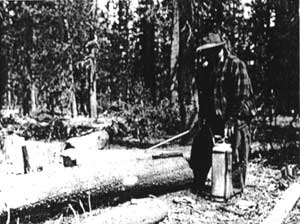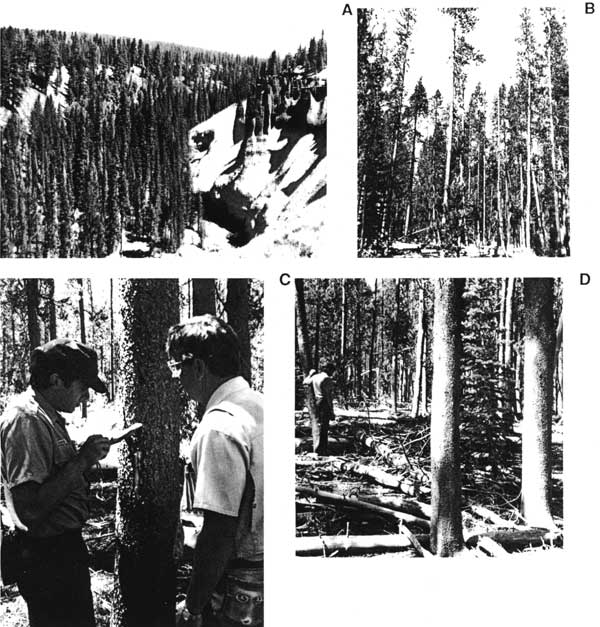The Battle Against Bark Beetles in Crater Lake National Park: 1925-34
The Aftermath
Hindsight is often 20/20, but it is hard not to give the beetles credit for defeating the puny efforts of the entomologists to stop the infestation. The outbreak covered a large area in and around the park, and most of the lodgepole pine stands in this area were at a susceptible age for attack. The control efforts may have delayed the killing of large old trees in high-use recreation areas, but one by one or two by two, most of them also fell victim either during the 8 years of the battle or in ensuing years. The main lesson learned was that once a mountain pine beetle population erupts over a large area of susceptible forest type, and as long as environmental conditions remain favorable, there really is no way to stop it until almost all the susceptible trees are either killed or removed by logging. Killing beetles by treating trees with the solar method or piling and burning perhaps slows the progress of the outbreak, but the outcome is inevitable. Perhaps the cold winter in 1932-33 helped, but most importantly, the depletion of susceptible trees ended the outbreak rather than the annual control efforts for 10 years. And, as Keen himself so perceptively noted (see footnote 18), the lodgepole pine were but one step in the forest successional process on much of the area.
This lesson unfortunately was not learned at Crater Lake until very recently. In 1946, the mountain pine beetle populations again appeared to be erupting in Pinnacles Valley, Crater Lake National Park. A report by R.L. Furniss, entomologist, Bureau of Entomology Laboratory, Portland, OR, recommended control in 1947 by using the solar-heat method and a new insecticide,
Orthodichlorobenzene, [47] mixed with fuel oil and applied to the infested trees. [48] In 1947, Patterson was again placed in charge of the control project, and he reported 1,022 trees treated in the old control units of 1929-33. He recommended that an estimated 130 infested lodgepole be treated in 1948. [49] Only
|
|
134 trees needed treating in 1948, and that was apparently the end of the outbreak. [50] In 1959, a small center of infestation containing several hundred trees along Bear Creek was treated by Park Service crews. By fall 1960, Buckhorn reported control work in the Pinnacles Valley and Bear Creek drainages from September 2 through November 10, 1960, resulted in the treatment of 2,113 trees. [51] This apparently was the end of that outbreak for there are no other references in the files.
All remained quiet until 1984, when lodgepole pine stands in central Oregon were once again ravaged by the mountain pine beetle. By 1985 a severe outbreak covered thousands of acres and extended south nearly to the park boundary. In 1986, beetle-killed trees were found in the northern end of the park. In August 1987, I visited Pinnacles Valley with Jim Milestone of the Park Service and Forest Service entomologist Russ Mitchell. We found groups of lodgepole pine being attacked by the mountain pine beetle, so we have come full circle with a new outbreak in progress.
This story can be best ended with the following ditty by an anonymous author: [52]
The Song of a Park Ranger
The bugs they’re killing the timber
They’ve worked for many a year,
But the Entomologists come and prophecy
That they’ll quickly disappear.
Chorus: Oh! they ain’t gwine fly no more, no more,
They ain’t gwine fly no more.
But how in the – – can the bug men tell
They ain’t gwine fly no more.
The crews are cutting the timber
The crews are peeling the bark,
The bug men say the beetles they’ll slay
And clean them from the Park.
Chorus:
And now the work is finishedThe Park is free for a century,
Unless the bug men are wrong.
Chorus:
***previous*** — ***next***



